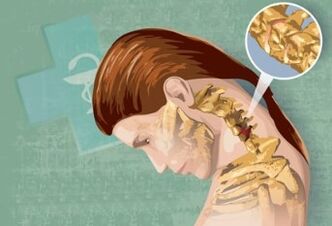In the modern world, the response of the disease of cervical osteochondrosis is difficult to overestimate.Osteochondrosis of the cervix region is much more common than in other vertebrates.This disease has almost all people over twenty -four years old except for one or the other degree.

A cervical osteochondrosis develops mainly due to a seated lifestyle that is particularly facilitated by the historical transition of a person from physical work to mentally, which, albeit to a moderate extent, goes hand in hand with the performance of work in the seating position.
Osteochondrosis of the cervical spine is a degenerative-dystrophic disease of the cervical spine, which leads to the damage to the intervertebral discs of the intervertebral discs, which often occurs for osteochondrosis disease.Since this section of the spine is due to its nature, it is also susceptible due to a poorly developed sore muscles, which is why the negative effect on the neck or back does not affect the cervix region well.Due to the fact that degenerative changes develop most often in the most mobile vertebrates, the nervous endings on C5 ... C7 suffer most often in the cervix region.
Since the symptoms of the neck osteochondrosis are very contradictory, they are not always considered to be symptoms of this disease, which often leads to the treatment of other medical areas.Do not look at them anymore.
Cervical osteochondrosis and their symptoms
Due to the fact that the cervical spine is quite compact compared to its other departments, it is not even a large voltage of the muscles of the sheikh or the shift of the vertebral of the cervix region, and can also lead to the nerve roots squeezed or defined, which can also be exposed to the vessels in this section.Well, osteophytes are bone growth, in folk treatment, which is referred to as "deposition of salts" and formed under the diseases of the development of the disease of cervical osteochondrosis, which, as a result, only lead to a significant deterioration of the disease.
Clinical manifestations of the disease of cervical osteochondrosis, ie their symptoms, can be divided into reflex symptoms and radicular symptoms of cervical osteochondrosis.
Reflex symptoms of a neck osteochondrosis
The reflex symptoms of a neck osteochondrosis include the so -called "recordings", which are expressed when acute acute pain in the neck appears and are significantly intensified in all movements.In view of this, patients often take a forced, most convenient position of the head.In addition, the emergence of a typical “criter” during the curves or other movements of the head is also possible.

In the event of cervical osteochondrosis, patients often experience headaches in nature and radiation in the eyebits or in the temporal part of the head.In addition, the severity of visual perception can sometimes fall as if "everything floats in front of my eyes".
The vertebral artery syndrome can also develop if its nervous plexus is irritated, which very often diagnoses a disruption of the blood circulation in the brain due to dizziness.Such a symptom of cervical osteochondrosis can manifest itself with sharp head movements and complicate nausea and possible vomiting.
In addition to the reflex symptoms of the cervical osteochondrosis mentioned above, cardiological syndrome also includes, in which sensations arise similar to an angina attack.However, such a manifestation of symptoms of osteochondrosis is usually combined with the complex and other signs of this disease, so that it usually does not cause any difficulties in the correct diagnosis.
Symptoms of cervical osteochondrosis
The radicular symptoms of cervical osteochondrosis usually appear due to the compression of the spinal nerve nerve - the spine.In this case, sensitive diseases that influence the motor functions completely depend on which specific nerve roots are violated, namely:
- C1 - a decrease in sensitivity in the neck;
- C2 - the occurrence of pain in the parietal or occipital area of the head;
- C3 - impaired sensitivity and the occurrence of pain in the neck, the trauma of the spine with a very possible impairment of the language function due to the loss of sensitivity of language and control over it;
- C4-das appearance of pain and a decrease in sensitivity in the shoulder-lopatic spine area as well as pain in the heart and in the liver with the simultaneous decrease in the muscle tone of the neck and the possible respiratory diseases of breathing function;
- C5 - A decrease in sensitivity and the occurrence of pain on the outer shoulder surface;
- C6 pain, radiation from the cervix spatula, the outer surface of the shoulder, the forearm and then from the radiation gel to the thumb of the hand;
- C7- and the same pain as with C6, but stroll from the shoulder blade on the back of the shoulder and then from the forearm to 2..4 fingers of the hand, with a reduction in sensitivity in the pain area;
- C8 - A decrease in sensitivity and pain that go from the neck on the shoulder and then from the forearm to the little finger of the hand.

Cervical osteochondrosis and their treatment
Cervical osteochondrosis is a fairly complex and extremely unpleasant illness in which treatment, duration and stage are required.The therapeutic treatment of cervical osteochondrosis initially aims to complete pain symptoms of a neck osteochondrosis and the elimination of inflammation in the neck affected by the disease.
Patients are carried out in the treatment of cervical osteochondrosis by classic analgesics.Although recently the non -steroidal anti -inflammatory medication effectively relieves pain in the treatment of osteochondose of the cervical spine and reduces the activity of inflammation in the treatment of osteochondrosis of the spine.
Among other things, chondroprotectors are also used to treat cervical osteochondrosis, which slow down the process of destroying the cartilage tissue and according to so many specialists who also contribute to the regeneration process.In addition, patients are prescribed by the use of vitamins B that improve the metabolic processes in the patient's body.
However, the use of external gels or ointments for the treatment of cervical osteochondrosis is not effective, but the meaning, since an additional massage of the cervical spine is also carried out in the process of rubbing into the skin.
In addition, physiotherapy methods in combination with traditional drug treatment for osteochondrosis of cervix and in particular the use of magnetotherapy are particularly effective by special medical devices, for example a house apparatus that has weakened well with specialists and patients.In addition to the therapeutic massages, physiotherapy exercises and manual therapy mentioned above, it is also used.In particularly serious cases of the disease, however, surgical intervention may be necessary.
Prevention of the disease of the neck osteochondrosis
The prevention of the cervix osteochondrosis itself is not complicated.Recommended:
- lead an active and healthy lifestyle,
- Drive sports or at least tomorrow -gymnastics,
- competent organization of the workplace,
- Compliance with the regime of work and calm,
- Cover a warm up several times during working hours during working time and ensure the correct position of the head and keeping during work.
The selection of a comfortable pillow and a comfortable mattress for sleeping is also important.For those who already suffer from this disease, daily use for a comfortable sleep from specialized orthopedic products is urgently recommended.




















